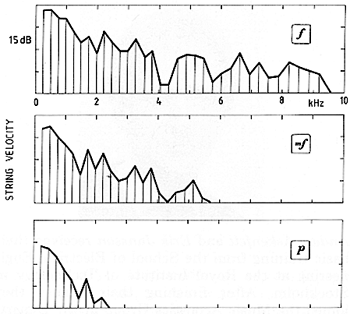 Fig. 20. Comparison of the spectra for a piano tone at three dynamic levels, p - mf - f, showing the boost of the higher partials with rising dynamic level (C4).
Fig. 20. Comparison of the spectra for a piano tone at three dynamic levels, p - mf - f, showing the boost of the higher partials with rising dynamic level (C4).

[<- Previous] [Contents of this lecture] [Next ->]
The most remarkable feature of the tone generation in the piano still remains to be presented. In almost all traditional instruments, the tone quality changes with the dynamic level. This means that a note in forte not only is an amplified version of the same note in piano, but also contains many more high frequency partials. Apparently this has been a desired property in the design of the traditional musical instruments - which by the way has caused the designers of synthesizers much trouble - but the reasons for it can only be speculated on. One answer could be that the traditional instruments simulate the properties of the human voice, for which such a spectral sharpening with level is normal, and in fact almost impossible to suppress.
Anyway, the boosting of the higher partials with rising level can be achieved by a variety of mechanisms, different for different types of instruments. They have only one property in common; the generated waveform - be it a variation in air pressure as in the wind instruments or the motion of a string as in the violin or in the piano - will exhibit more abrupt twists and turns and hence more high frequency Fourier components (partials), the higher the dynamic level. For instance, in the clarinet the design of the reed and the closing surface of the mouthpiece are responsible for the increasing "distortion" of the waveform with rising level. In the violin, a strange friction characteristic between the rosined bow hair and the string serves the same purpose.
A corresponding feature is also incorporated in the piano. The secret is hidden in the felt hammers which become progressively harder the more they are compressed (nonlinear stiffness). The result is remarkably indeed; the hammer "feels" soft to the string when striking at a low velocity (piano), but "transforms" to a much stiffer piece of felt when striking at a high velocity (forte). This increase in effective stiffness sharpens the initial pulse created at hammer contact, and the high-frequency part of the spectrum is enhanced at loud dynamics, as illustrated in Fig. 20. The changes are large, in fact much larger than the changes reached in the experiments with exchanged hammers or voicing. It is very likely that without this design feature of "an automatic treble control connected to the volume knob," the piano would never have reached its present high appreciation.
 Fig. 20. Comparison of the spectra for a piano tone at three dynamic levels, p - mf - f, showing the boost of the higher partials with rising dynamic level (C4).
Fig. 20. Comparison of the spectra for a piano tone at three dynamic levels, p - mf - f, showing the boost of the higher partials with rising dynamic level (C4).
The properties of the hammers are thus most critical to the performance of a piano. In paraphrasing certain advertisements of automobile manufacturers it could be said: "Use only original spare parts!" and indeed, poor hammers will certainly ruin the sound of even the best of pianos. Also, service should be carried out by professionals only. An experienced piano tuner/technician should be welcomed periodically into every home which appreciates a well-playing piano.
[<- Previous] [Top] [Contents of this lecture] [Next ->]
This lecture is one of Five lectures on the Acoustics of the piano
© 1990 Royal Swedish Academy of Music